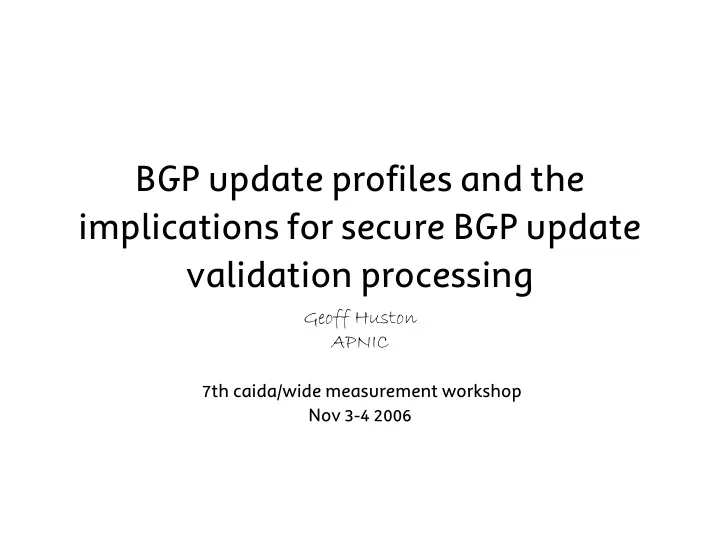

BGP update profiles and the implications for secure BGP update validation processing Geoff Huston APNIC 7th caida/wide measurement workshop Nov 3-4 2006
Why? • Secure BGP proposals all rely on some form of validation of BGP update messages • Validation typically involves cryptographic validation, and may refer to further validation via a number resource PKI • This validation may take considerable resources to complete. • This implies that the overheads securing BGP updates in terms of validity of payload may contribute to: – Slower BGP processing – Slower propagation of BGP updates – Slower BGP convergence following withdrawal – Greater route instability – Potential implications in the stability of the forwarding plane
What is the question here? • Validation information has some time span – Validation outcomes can be assumed to be valid for a period of hours • Should BGP-related validation outcomes be locally cached? • What size and cache lifetime would yield high hit rates for BGP update validation processing?
Method • Use a BGP update log from a single eBGP peering session with AS 4637 over a 14 day period – 10 September 2006 – 23 September 2006 • Examine time and space distributions of BGP Updates that have similar properties in terms of validation tasks
Update Statistics for the session Day Prefix Duplicates: Duplicates: Duplicates Duplicates Updates Prefix Prefix + Prefix + Prefix + Comp-Path Origin AS AS Path 1 72,934 60,105 (82%) 54,924 (75%) 34,822 (48%) 35,312 (48%) 2 79,361 71,714 (90%) 67,942 (86%) 49,290 (62%) 50,974 (64%) 3 104,764 93,708 (89%) 87,835 (84%) 65,510 (63%) 66,789 (64%) 4 107,576 94,127 (87%) 87,275 (81%) 64,335 (60%) 66,487 (62%) 5 139,483 110,994 (80%) 99,171 (71%) 68,096 (49%) 69,886 (50%) 6 100,444 92,944 (92%) 88,765 (88%) 70,759 (70%) 72,108 (72%) 7 75,519 71,935 (95%) 69,383 (92%) 56,743 (75%) 58,212 (77%) 8 64,010 60,642 (95%) 57,767 (90%) 49,151 (77%) 49,807 (78%) 9 94,944 89,777 (95%) 86,517 (91%) 71,118 (75%) 72,087 (76%) 10 81,576 78,245 (96%) 75,529 (93%) 63,607 (78%) 64,696 (79%) 11 95,062 91,144 (96%) 87,486 (92%) 72,678 (76%) 74,226 (78%) 12 108,987 103,463 (95%) 99,662 (91%) 80,720 (74%) 82,290 (76%) 13 91,732 87,998 (96%) 85,030 (93%) 72,660 (79%) 74,116 (81%) 14 78,407 76,174 (97%) 74,035 (94%) 64,994 (83%) 65,509 (84%)
CDF by Prefix and Originating AS
Time Distribution 1.2e+06 1e+06 Cumulative Total of Recurring Updates 800000 600000 400000 200000 Prefixes Prefix + Origins Prefix + Path Prefix + Compressed Path 0 0 10 20 30 40 50 60 70 80 90 Update Recurrence Interval (Hours)
Time Spread 100 Cumulative Proportion of Recurring Updates (%) 80 60 40 20 Prefixes Prefix + Origins Prefix + Path Prefix + Compressed Path 0 0 10 20 30 40 50 60 70 80 90 Update Recurrence Interval (Hours)
Space Distribution • Use a variable size cache simulator • Assume 36 hour cache lifetime • Want to know the hit rate of validation queries against cache size
Prefix Similarity 100 80 Validation Cache Hit % 60 40 20 0 1 10 100 1000 10000 100000 Cache Size
Prefix + Origin Similarity 100 80 Validation Cache Hit % 60 40 20 0 1 10 100 1000 10000 100000 Cache Size
Prefix + Path Similarity 100 80 Validation Cache Hit % 60 40 20 0 1 10 100 1000 10000 100000 Cache Size
Observations • A large majority of BGP updates explore diverse paths for the same origination • True origination instability occurs relatively infrequently (1:4) ? • Validation workloads can be reduced by considering origination (prefix plus origin) and the path vector as separable validation tasks • Further processing reduction can be achieved by treating a AS path vector as a sequence of AS paired adjacencies
AS Path Similarity 100 80 Validation Cache Hit % 60 40 20 0 1 10 100 1000 10000 100000 Cache Size
AS Pair Similarity 100 80 Validation Cache Hit % 60 40 20 0 1 10 100 1000 10000 100000 Cache Size
Observations • Validation caching appears to be a useful approach to addressing some of the potential overheads of validation of BGP updates • Separating origination from path processing, using a 36 hour validation cache can achieve 80% validation hit rate using a cache of 10,000 Prefix + AS originations and a cache of 1,000 AS pairs
What do we want from secure BGP? • Validation that the received BGP Update has been processed by the ASs in the AS Path, in the same order as the AS Path, and reflects a valid prefix, valid origination and valid propagation along the AS Path? or • Validation that the received Update reflects a valid prefix and valid origination, and that the AS Path represents a plausible sequence of validated AS peerings?
Further work? • Heaps!
Thanks Questions?
Recommend
More recommend